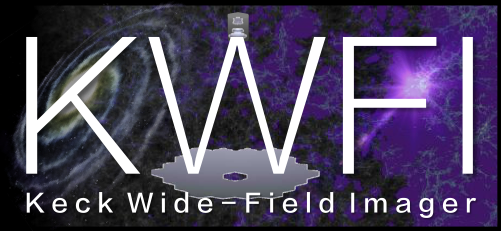KWFI Science Cases document can be found here
Deep, wide-field imaging is essential for nearly all areas of astronomy. With its exceptional depth and blue sensitivity, KWFI will resolve long-standing problems in astrophysics, enable new science only possible at Keck, and will progress areas of high-impact discovery. Some KWFI science cases include.
Lyman Continuum at high redshift: KWFI will be the only wide-field instrument in the world capable of detecting faint Lyman continuum flux from z ~ 3 – 5 galaxies, including low-mass galaxies, to understand the main sources responsible for cosmic reionization.

Gravitational Wave counterparts: KWFI is necessary for early detection of distant BNS kilonovae and faint NS-BH counterparts well localized by future 5-detector and 3G gravitational wave observatories for many science goals, including measuring the Hubble constant, understanding heavy element synthesis, and the physics of compact object mergers.

Roman, Euclid, TMT, and JWST: Roman and Euclid have a 0.28 deg^2 and 0.53 deg^2 fields of view, respectively, and will conduct deep field (m ~ 28–29) programs in the O/IR down to about ~5500A. KWFI is the only instrument capable of complementary deep (m ~ 28–29) wide-field optical imaging down to ~3000A. In addition, KWFI will detect key rare targets, lensed targets and transient events for TMT and JWST spectroscopic follow up.
High redshift galaxies: KWFI deep, blue, wide-field imaging will enable high redshift galaxy and large-scale clustering studies. KWFI will reach to low masses and the faint end of the luminosity functions and the Lyman alpha emitter/damped Lyman alpha absorber interface and to explore Lyman alpha emitters at high redshift and also down to z ~ 1.5, where the searches are ‘clean’ with no lower redshift emission line ‘interlopers’. KWFI will provide wide-field, deep, and densely sampled targets for FOBOS, Subaru Prime Focus Spectrograph (PFS), Maunakea Spectroscopic Explorer (MSE), as well as TMT spectroscopic and adaptive optics targets.
High redshift supernovae and the first stars: Deep galaxy surveys that are acquired with smart cadence enable the detection and study of UV-luminous supernovae to z ~ 6. Classical observing (i.e., no ToO observations) can acquire spectroscopy of the time dilated evolution superluminous supernovae and other supernovae at high redshift. Characterizing the UV of supernovae with KWFI and follow-up spectroscopy with Keck instruments, TMT, and JWST will enable their detection and study to z ~ 20 and the epoch of the first stars using NASA Roman space telescope and other facilities and TMT and JWST spectra.
Fast Radio Bursts (FRBs) : FRBs directly probe the cosmic ionized baryons, but their nature is unknown (some may be magnetars). Deep u-band over > 2 deg2 per FRB sightline is needed for accurate phot-zs to map galaxies and measure the ionized baryon contribution. Only KWFI can reach theorized optical depths over the radio localization regions to detect optical counterparts to uncover their nature and to search for events without radio. KWFI corner CMOS detectors will enable the deepest millisecond searches for FRB repeaters.
The Circumgalactic Medium (CGM): KWFI can provide extremely deep, wide-field narrowband imaging of the diffuse emission from the CGM at low to high redshift (using the same filters) in Lyα, OVI, MgII (at low-z, HI is radio accessible) over 10s of Mpc environments.
Fast and Early Transients: Fast transients and very early transient detections are rare, hot, and require deep, wide-field, blue imaging to probe large cosmological volumes for detection, providing crucial information on their physics and to discover unknown classes.
Massive galaxy clusters and lensing: Deep u-band/optical imaging over wide fields is needed for accurate phot-zs to map low-z massive galaxy clusters identified by e.g., eROSITA to measure their dark matter and search for lensed sources, including SNe.
Globular Clusters (GCs): Deep, wide-field u-band is crucial to GC selection. As bright tracers of galaxy halo chemodynamics and accretion histories, KWFI will compile an unprecedented census in all galaxy types and environments beyond our local group.
Local Galaxies: KWFI will be powerful to map stellar halos and galaxy satellites to ∼10 Mpc, including their density, metallicity, and substructure. KWFI is ideal to detect low-surface brightness, ultra-diffuse, and ultra-faint galaxies, stellar streams and shells.
Supernova remnants and light echos: Wide fields (up to several to many deg2) and deep u- band/optical imaging are needed to study very faint supernova remnants and light echos to determine supernova type and measure e.g., chemical yield, energy, and kinematics.
Milky Way Star Formation and Feedback: Wide-field (> 0.5–1 deg) narrowband imaging is required map star forming regions to understand stellar feedback mechanisms, e.g., protostellar outflows and UV radiation, that determine the final mass of stars and the IMF.
Stellar metallicities: Deep u, g, and i-band imaging over many square degrees is an efficient method to measure stellar population metallicities and, with Ca H&K narrowband imaging, to identify metal poor stars in Milky Way and Local Group.
Solar System: KWFI will enable the discovery and study of TNOs, KBOs, the ninth planet, NEOs that can have ∼1 deg uncertainties, and comets emitting large u-band gas (OH,NH,CN) comas at 26–27 mag/deg2 for their gas production, rotation, and composition.
And many more areas of research …
KWFI is a collaboration of the following institutions:















